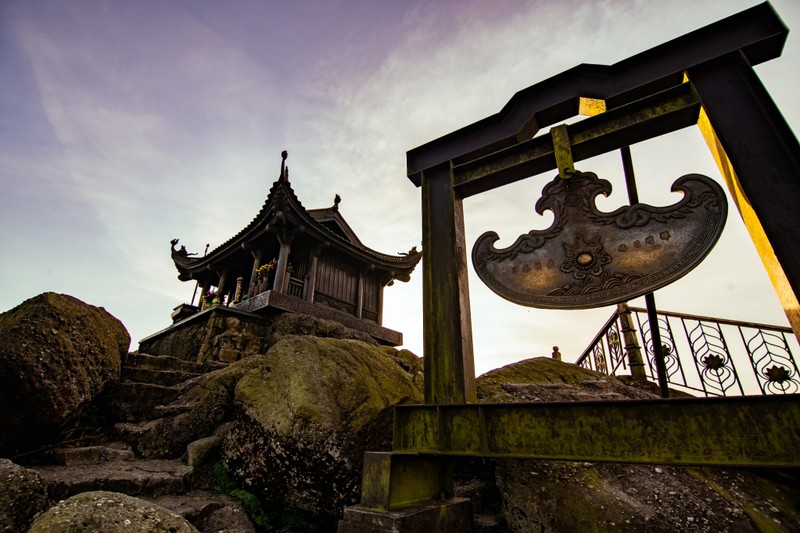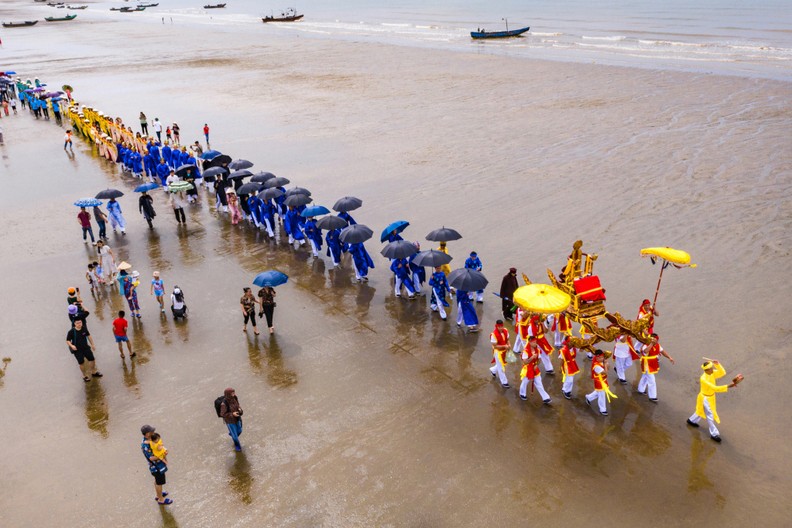Quang Ninh has not only been famous as the largest coal industrial region in Vietnam but also its precious natural and cultural heritages, both given by nature and created by humans. Quang Ninh culture has interference, convergence, and unity in the diversity of Red River civilisation including marine culture, mine worker culture, the unique culture of ethnic minorities and the Buddhist culture of Truc Lam Yen Tu. They crystallise and converge to create unique characteristics.

Dong Pagoda on top of Yen Tu Mountain. (Photo: Pham Hoc/baoquangninh.vn)
Quang Ninh has a large, rich, diverse and unique cultural heritage treasure. The province is preserving and developing 637 historical and cultural relic sites and scenic spots, as well as over 2,800 intangible cultural heritages, including customs, folk games and festivals of more than 42 ethnic minority groups. In particular, there are six special national relic sites, 58 national relic sites, 82 provincial relic sites and 482 inventoried and classified relics. There are 362 intangible cultural heritages, including six listed among national intangible cultural heritages and about 80 archaeological sites, many of which are relic sites. Besides tangible and intangible cultural values, Quang Ninh’s people have been known for many unique values that were formed and cultivated over many generations. One of these values is the spirit of “Discipline and Consistency”.
In addition, Quang Ninh’s culture is also the crystallisation of the cultural identity of 23 ethnic groups residing in the province, including 22 ethnic minorities mainly living in communities in the mountainous, border and remote areas in the eastern part of the province, such as the Tay, Dao, San Diu, San Chay and Hoa. Many ethnic minority groups have formed their own identities and preserved treasures of cultural heritage, that have been cultivated over thousands of years, becoming invaluable assets that need to be cherished, respected and preserved.
Especially, Quang Ninh's intangible culture is a combination of elements of exchange, integration, reconciliation, acculturation, openness, and flexibility to create the identity of the Mining region, a "miniature Vietnam". There are 64 traditional festivals imbued with characteristics of each region, as well as a series of different heritages, including folk literature (epics, folk songs, proverbs, chants, rhymes, couplets, fairy tales and stories) and folk performing arts ( music, dance and theatre). They are also social customs, folk knowledge and traditional arts.

Tra Co Communal House Festival is recognised as a national intangible cultural heritage. (Photo: Duong Minh Toan/baoquangninh)
In addition, Quang Ninh culture also has its unique characteristics with the "mine worker culture" that was formed and has been developed for nearly 150 years, associated with the labour process and revolutionary struggle. The culture of the Mining region is a combination of two elements, including traditional cultural features and modern culture, contributing to making Quang Ninh's cultural heritage richer and more diverse.
To preserve and promote its cultural values, Quang Ninh Province has paid great attention to repairing and embellishing historical, cultural, and revolutionary relic sites, along with the effective implementation of socialisation work. In the past five years (2018 - 2022), 100% of national relics and 70% of provincial relic sites have been repaired, restored and prevented from degradation, with a total cost of over 1,683 billion VND from state, local and socialised resources. In addition, the province has conducted an inventory of seven types of intangible cultural heritage and carried out many programmes and projects.
Through inventory activities, the province has proposed the Ministry of Culture, Sports and Tourism to recognise six national intangible cultural heritages. The locality’s cultural sector has also collaborated with the Institute of Music and Vietnam National Academy of Music, to study and record videos about Then rituals of the Tay ethnic minority people in Binh Lieu District, as well as worked with ten provinces in the country that have Then heritage, to prepare a dossier to submit for UNESCO’s recognition as an Intangible Cultural Heritage of Humanity.

The performance of Then singing and Tinh flute by the Tay ethnic minority people in Binh Lieu District. (Photo: Nguyen Dung/baoquangninh)
Quang Ninh Province has also focused on directing the research and creation of cultural, artistic and handicraft products imbued with local characteristics, as well as tangible and intangible cultural heritages, serving economic and social development. In some localities in the province, handicraft products, ecological and experiential tourism products have affirmed their brands and approached both domestic and international markets, such as some traditional ceramic craft villages (Dong Trieu provincial-level Town), making wooden ships (Quang Yen Town) and pearl farming (Van Don District). Currently, about 120 relic sites and heritages are included in tours and tourist routes around Quang Ninh Province.
Notably, Quang Ninh has recorded a breakthrough in mobilising investment resources for modern and synchronous cultural and sports institutions. The cultural industry has been initially formed, and several typical cultural products have been created towards attracting the attention of a large number of tourists and improving the cultural and spiritual life of the locals.